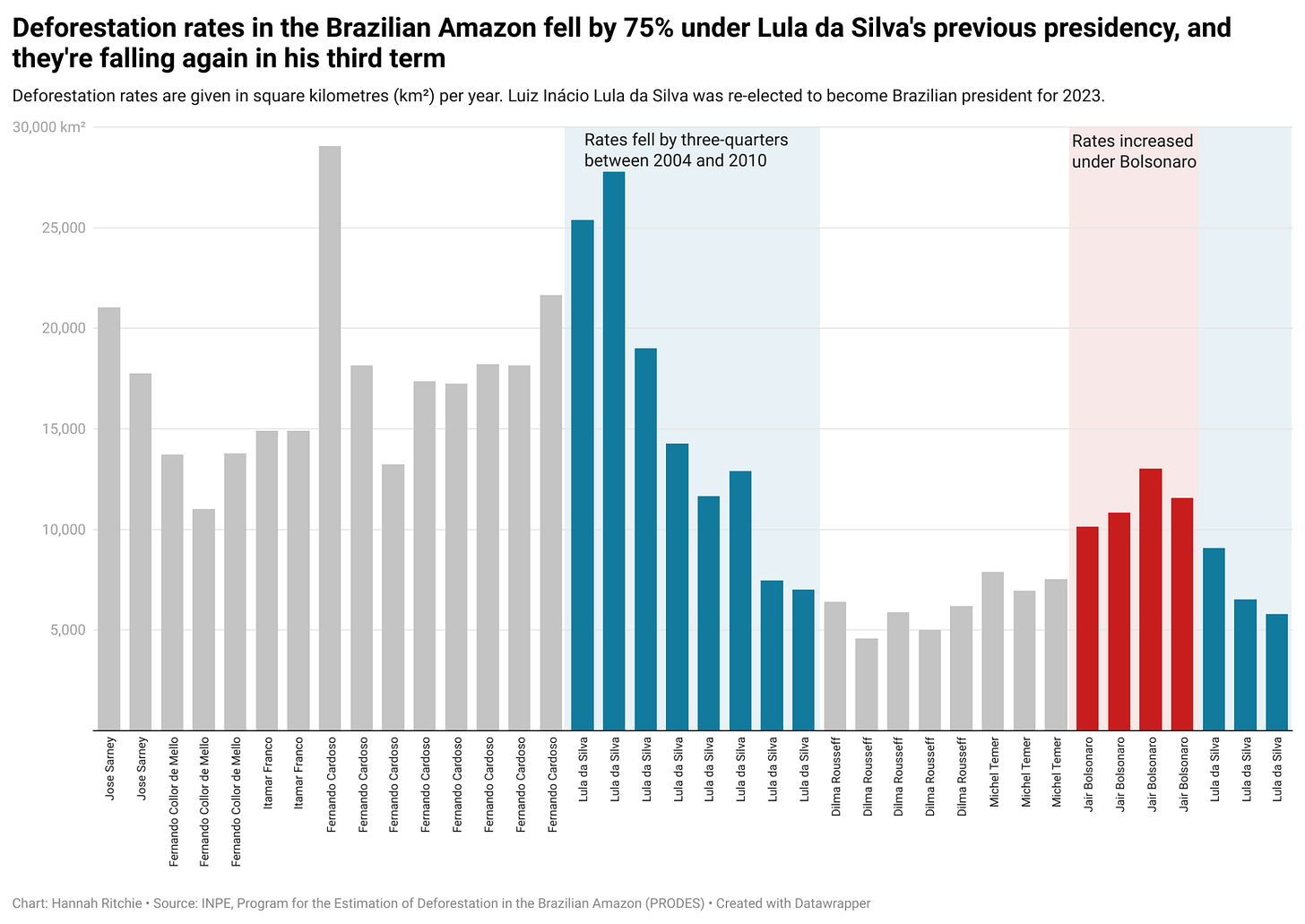Deforestation in the Brazilian Amazon has fallen again in 2025
Progress on deforestation, but increased threats from wildfires.
This year, 5,800 square kilometres (km2) were cleared, which was an 11% drop compared to last year. You can see this in the chart below, which shows deforestation rates since the late 1980s.
This data comes from PRODES (Program for the Calculation of Deforestation in the Legal Amazon), which carries out satellite monitoring of the region to detect deforestation. It also incorporates data from DETER, which is a rapid alert system that tries to detect changes in forests as they happen.
Brazil’s current president, Lula da Silva, returned to office in 2023. Since the start of his term, rates have more than halved. You can see this in the green shading below. The red bar represents the final year of Jair Bolsonaro’s term, who, it’s fair to say, wasn’t the strongest advocate for environmental protection.
When it comes to energy policy, there can be quite a lag between someone taking office and instating policies, and that actually showing in the data. Donald Trump has not been quiet about trying to halt renewable projects, yet this year the US will see record installations of solar capacity. This is mostly a legacy spillover from projects initiated under Biden’s previous term. His attempts to slowdown renewables will probably be seen in the next few years.
But deforestation is one area where a change in leadership has had quite immediate impacts. Below, I’ve plotted the Amazon deforestation rates with the sitting president labelled below.
Lula da Silva’s terms are shown in blue; Jair Bolsonaro’s in red. Amazon deforestation fell dramatically in Lula’s first term. It rose substantially under Bolsonaro, and is falling again.
Improvements in the quality and resolution of monitoring alerts — such as those through the DETER program — and stricter enforcement of penalties for illegal land-clearing have been important in driving this decline.
In 2004, Brazil established its “Action Plan for the Prevention and Control of Deforestation in the Legal Amazon”. In 2019, under Bolsonaro, this was defunded. But it was revived again in 2023.
Deforestation rates have fallen, but it has been a bad few years for wildfire damage
Deforestation — which is specifically the clearing of forests for alternative land use — has been declining over the last few years.
But forest degradation, which is a thinning of the forest or a reduction in its quality, can happen for a variety of reasons. This degradation has been high over the last few years — particularly in 2024 — due to large wildfires.
While this isn’t the same as the permanent conversion of forested land, these fires do fracture the density and resilience of the Amazon, which is already under threat from continued deforestation.
Two final notes.
Less deforestation is good, but the region is still losing a lot of forest each year. Rates are not yet back to their record lows in Lula’s first term. The goal is not just to get rates down, but to get them to zero.
Finally, later this month Brazil will host COP30. There are reports of parts of the Amazon being cleared to make space for new roads ahead of the event. The local government maintains that these infrastructure plans predate the announcement of the climate summit, but hosting the summit has likely accelerated them.
Regardless, the irony of this is not lost on me. While the area cleared for this is probably small relative to the total amount lost this year, the optics for people who don’t take climate change — and these events — seriously are not great, to say the least.





Always great reading your stuff, Hannah. But please add a cumulative plot near tge top of yhis article to remind us all that we are still going in the wrong direction, even though we are slowing down.
Good news (relatively speaking). I’m also curious about the flip side of this equation, i.e., how much of the Amazon has been reforested. That’s a tricky one, I’m sure, because of the qualitative difference between secondary forest and old growth but it would be good to see some reliable numbers about it. If you know a good source, please pass it along.